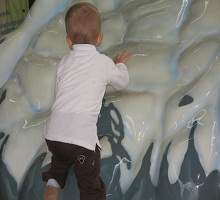Child and passive smoking

How many cigarettes does your child smoke per day? Your child does not smoke?
In 1974, a British epidemiologist Dr.Colley found a high incidence of respiratory disease in young children, in whose presence parents smoke. His and other studies have become the first evidence of harmful effects of passive smoking, not only for children but also for every adult who inhales smoke produced by a smoker. The results of other surveys have shown that passive smoking is the third leading cause of death, after active smoking and drinking alcohol. The reason for that can be easily influenced by prevention.
If the child is breathing air polluted by tobacco smoke, it may also have consequences, as if he/she was a smoker.
Passive smoking
is involuntary breathing of smoke, which the non-smoker is forced to breathe in the space around the smoker.
There is about 4,000 chemicals in burning cigarette, which are absorbed to the air from the so called main and side stream of cigarette smoke. Only 15% is inhaled by the smoker, the remaining 85% may be inhaled by other people.
Both streams contains almost the same chemicals, but:
Main stream occurs at the end of a burning cigarette. Smoker pulls it into the lungs through cigarette, which filters some chemicals. Furthermore, this smoke is filtred by smoker's lungs which retain 80% of the chemicals. Exhausted smoke is diluted and partially "cleaned".
Side stream of cigarette smoke occurs between smoker's sucks in the burning end of the cigarette and gets directly into the ambient air. By being undiluted and not filtered, it has a much higher concentration of the toxic and carcinogenic substances compared to the main stream.
It has:
2-20 times of nicotine
5-15 times the carbon monoxide
50 to 130 times the content of carcinogens
compared to the mainstream.
So, the side stream of tobacco smoke is therefore a greater health risk to humans than the mainstream.
(Of course, the smoker is at a health risk facing both streams at the same time).
The most serious problem is smoking in the presence of children.
Children have low weight. Their lungs are smaller and they breathe faster than adults, suggesting that at the same time they breathe much more pollutants per kilogram of body weight than adults. Their immune system is less developed and the development of respiratory tract infections is much more easier. Adults can choose to remain in a smoky room or leave. Children often can not choose, especially if parents or relatives smoke at home, in a family environment.
The consequences of passive smoking on children:
- increases the incidence of respiratory diseases (especially in children during the first year of life)
- increases the severity of symptoms of bronchial asthma
- it is a major cause of sudden infant death syndrome (SIDS)
- it makes minor changes in lung function
- the cause of middle ear disease
- there is a suspicion that passive smoking of children younger than ten years of age increases the risk of developing a leukemia (cancer of blood-forming cells) and lymphoma (cancer of the lymphatic system) in adulthood.
Do not smoke in the presence of children!
To protect children from passive smoking is the primary task of preventing many diseases that threaten the child. Every adult who smokes in the presence of children should be aware of a serious threat not only to their health but also the health of other adults – non smokers. Every smoker should change their own smoking behavior and try to create the conditions where children are not exposed to the effects of tobacco smoke. No non-smoker and child should leave the area where smoker wants to smoke, but it should suffice one nonsmoker and one child for smoker to leave a common room.




